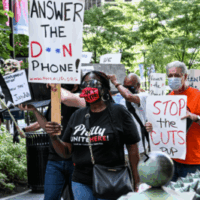The Unemployment Insurance Modernization and Recession Readiness Act Will Help Workers and the Economy Thrive
Anyone who is out of work should be able to sustain themselves and their families while they look for a new job. But less than 30 percent of unemployed workers received support from unemployment insurance (UI) in 2023, [1] and workers of color are disproportionately excluded.[2] Without strong federal standards for unemployment benefits, workers in many states struggle to get by and many see their benefits cut off before they find work. And while UI is among the most effective policies to speed recovery from an economic downturn, the system is flawed. In recent economic downturns, Congress scrambled to create temporary emergency unemployment programs because the regular UI system was too weak to adequately support workers or the economy.
The UI Modernization and Recession Readiness Act takes a major step toward fixing unemployment insurance so that all workers—and the economy as a whole—can thrive.
In recent economic downturns, Congress scrambled to create emergency unemployment programs because the regular UI system was too weak to adequately support workers or the economy.
The UI Modernization and Recession Readiness Act would automatically provide additional weeks of benefits when unemployment rises.
During economic downturns, unemployment benefits are among the most effective ways to stimulate economic recovery, producing $1.90 in economic growth for every dollar in benefits as workers and their families spend on basic necessities.[3] The Extended Benefits (EB) program is key to this economic stabilization, designed to make additional weeks of benefits available to workers in times of high unemployment. However, the triggers that switch EB on and off are not responsive enough to economic conditions to be effective. This bill fixes the triggers so that more weeks of EB automatically become available when unemployment increases and remain available long enough to adequately support unemployed workers and the economy. The legislation also makes extended benefits easier for states to administer and institutes full federal funding for EB.
The UI Modernization and Recession Readiness Act would set national standards so UI reaches more workers and provides better income support to workers and their families.
Today, the UI system is a patchwork of state systems with wildly divergent rules that leave millions of unemployed workers facing severe hardship when they can’t qualify for benefits, don’t receive enough to get by, or have benefits cut off before they find work. For example:
- In Kentucky, Florida, North Carolina, and Virginia, less than 13 percent of unemployed workers received unemployment benefits in 2023.[4]
- Ten states provided average benefits of less than $300 a week in 2023, while 24 states offered minimum benefits lower than $50 a week. In Mississippi, the average benefit was less than $221 a week, and the minimum benefit was just $30 a week.
- Florida and North Carolina provided a maximum of just 12 weeks of unemployment benefits in 2023—in these states 55 percent of workers receiving UI saw their benefits disappear before they could find new jobs.
The UI Modernization and Recession Readiness Act addresses these shortfalls by setting national standards all states must meet, including:
- Duration: All states must provide at least 26 weeks of benefits. This standard is particularly important for older workers, Black workers, and other workers of color, who face discrimination in hiring that makes it take longer to find a job, on average.
- Adequacy: UI benefits must replace 75 percent of a worker’s average weekly earnings, up to a maximum amount based on the state’s average weekly wage. During a public health emergency or major disaster, wage replacement rises to 100 percent and is entirely federally funded. The bill also establishes a federally funded supplement for workers’ dependents.
- Eligibility: Workers who were employed part-time or are seeking part-time work will be eligible for UI benefits. States must determine eligibility based on a worker’s most relevant recent work history and must recognize a range of reasons for workers to leave a job and still claim UI benefits, including quitting because of sexual harassment or loss of childcare. UI eligibility for temporary workers, student workers, school employees, and workers displaced by labor disputes is expanded.
- Other vital improvements: States must eliminate the antiquated one-week waiting period to claim benefits, use common-sense metrics for determining whether a worker is an employee, and establish a Short-Time Compensation program that will help preserve jobs when an employer would otherwise lay off workers for financial reasons.
A Jobseeker’s Allowance would aid workers who don’t qualify for UI.
During the pandemic, Congress provided unprecedented support to self-employed workers and others shut out of the UI system, bolstering millions of families and speeding economic recovery. The new Jobseeker’s Allowance would provide a permanent, federally funded benefit of $250 per week to unemployed workers who are seeking jobs but are not covered by UI or would receive only a small UI payment. Self-employed workers, those returning to the workforce after caregiving, extended illness, or incarceration, and new entrants to the labor market such as recent high school or college graduates would be among the beneficiaries.
Endnotes
[1] Unemployment Insurance Chartbook, U.S. Department of Labor, Employment and Training Program, 2023.
[2] Amy Traub and Kim Diehl, “Reforming Unemployment Insurance Is A Racial Justice Imperative,” National Employment Law Project, February 2022, https://www.nelp.org/publication/reforming-unemployment-insurance-is-a-racial-justice-imperative/.
[3] Marco Di Maggio and Amir Kermani, “Unemployment Insurance as an Automatic Stabilizer: The Financial Channel,” Harvard Business School Finance Working Paper, May, 2017, https://ssrn.com/abstract=2575434; Klaus-Peter Hellwig, “Supply and Demand Effects of Unemployment Insurance Benefit Extensions: Evidence from US Counties,” International Monetary Fund, 2021, https://www.imf.org/en/Publications/WP/Issues/2021/03/12/Supply-and-Demand-Effects-of-Unemployment-Insurance-Benefit-Extensions-Evidence-from-U-S-50112.
[4] All state statistics from the U.S. Department of Labor, Employment and Training Program, 2023.
Related to
Related Resources
All resourcesCase Study: How Virginia Worker Advocates Advanced Unemployment Insurance Reform in a Divided State Government

Policy & Data Brief
Letter on Making Reforms to Virginia’s Unemployment Insurance System

Comments & Letters
Letter on Rescinding Funds for Improving Unemployment Insurance Systems

Comments & Letters

